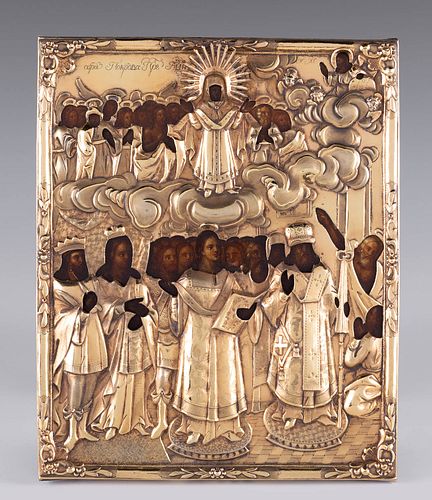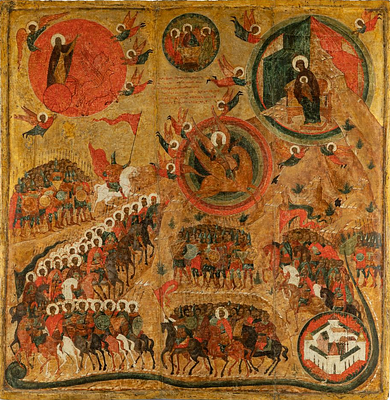Russian school, 18th c. Silver Oklad, 19th century. "The Protection of the Mother of God" or "The Virgin of Pokrov". Tempera on panel. Silver oklad.
Lot 67
About Seller
Setdart Auction House
Carrer Aragó 346
Barcelona
Spain
Setdart Subastas was born in 2004 and is currently the first online art auction in Spain with solidity, prestige and reliability guaranteed by our more than 60,000 users. Setdart has a young, dynamic and enterprising team ready to successfully manage the purchase and sale of art works through custom...Read more
Estimate:
EUR€3,500 - EUR€4,000
$3,645.83 - $4,166.67
Absentee vs Live bid
Two ways to bid:
- Leave a max absentee bid and the platform will bid on your behalf up to your maximum bid during the live auction.
- Bid live during the auction and your bids will be submitted real-time to the auctioneer.
Bid Increments
| Price | Bid Increment |
|---|---|
| EUR€0 | EUR€10 |
| EUR€200 | EUR€25 |
| EUR€500 | EUR€50 |
| EUR€1,000 | EUR€100 |
| EUR€3,000 | EUR€200 |
| EUR€5,000 | EUR€500 |
| EUR€10,000 | EUR€1,000 |
| EUR€20,000 | EUR€2,000 |
| EUR€50,000 | EUR€5,000 |
About Auction
By Setdart Auction House
Sep 23, 2021
Set Reminder
2021-09-23 10:00:00
2021-09-23 10:00:00
America/New_York
Bidsquare
Bidsquare : RUSSIAN ICONS
https://www.bidsquare.com/auctions/setdart-auction-house/russian-icons-7431
Setdart Auction House sofia@setdart.com
Setdart Auction House sofia@setdart.com
- Lot Description
Russian school, 18th c. Silver Oklad, 19th century. "The Protection of the Mother of God" or "The Virgin of Pokrov". Tempera on panel. Silver oklad. Measurements: 22 x 18 cm. The present icon represents one of the most recurrent scenes in orthodox icon painting which is "The Protection of the Mother of God", or more commonly known in Russia under the name "The Virgin of Pokrov". The painted icon is hidden behind a decorative silver plate, internationally known by the Russian term "oklad". The tradition of decorating icons with oklad appeared after the decree of the Most Holy Ruling Synod in 1722, when it was forbidden to hang metal crosses on icons and to leave offerings in the form of coins, as this tradition had pagan roots. This applied decoration is found almost everywhere in the world, but is most widespread in Central and Eastern Europe. And in the Orthodox tradition, the manufacture of these items became a separate type of art and craft: many travellers noted with admiration in their diaries the luxury of Ukrainian and Russian shrines. Oklads have not only an aesthetic but also a practical purpose. The icons painted on wood suffer from candle soot, humidity, temperature fluctuations and are constantly touched by parishioners. The paint also darkens, fades, cracks, crazes and rubs off. The oklad or "curling", another term used, protects the icons from damaging effects, prolonging their lifespan. As with icon painting, the materials used in making a decorative oklad have their own particular symbolism, which can tell a lot about the icon hidden underneath. For example, in the case of the auctioned icon, the main material, silver, symbolises purity and virtue, deliverance from sins and salvation of the soul. On the iconographic level, the theme of 'The Virgin of Pokrov' is one of the themes of the Russian Orthodox Church, although it depicts events that took place in Constantinople around 910. The story was originally taken from the biography of Andrew of Constantinople, who, together with his disciple Epiphanius, saw the Mother of God flying over the Church of St Mary of Blanquernas, covering the believers with her omophorion, a symbol of protection. On several occasions the story was modified, the last being the version of Bishop Demetrius of Rostov, composed towards the end of the 17th century, who said that among those who saw the miracle were John the Baptist, John the Apostle, Andrew of Constantinople, and King Leo the Wise. The significance of this miracle is that the Mother of God protected the city of Constantinople against the Muslim invasion. The prototype of the icon of the protection of the Mother of God developed around the 14th century, although it became more widespread in later centuries. There are two main types of representation of this scene. One, the older one, belongs to the Novgorod school. The other, the one in front of us, was developed in the Rostov and Suzdal school, and was finally implemented in the Moscow school. The latter typology is distinguished by the Mother of God depicted in the central register in front of the church. The omophorion, or "pokrov", with which she protects the believers, is held in her two hands, instead of being held by the two angels, as would be depicted by the Novgorod painters. Apart from the apostles, various martyrs, and Andrew of Constantinople, the lower central register, just below the Virgin, depicts a figure typical of the Rostov school, Roman the Méloda, the author of several songs dedicated to the Virgin Mary. It is worth noting that on either side of the scene we see Saint Alexius of Rome, or Saint Alexius the Beggar, and the martyr Anisia of Thessalonica.
- Shipping Info
-
In-house shipping available. Please inquire at admin@setdart.com.
-
- Buyer's Premium



 EUR
EUR CAD
CAD AUD
AUD GBP
GBP MXN
MXN HKD
HKD CNY
CNY MYR
MYR SEK
SEK SGD
SGD CHF
CHF THB
THB
















